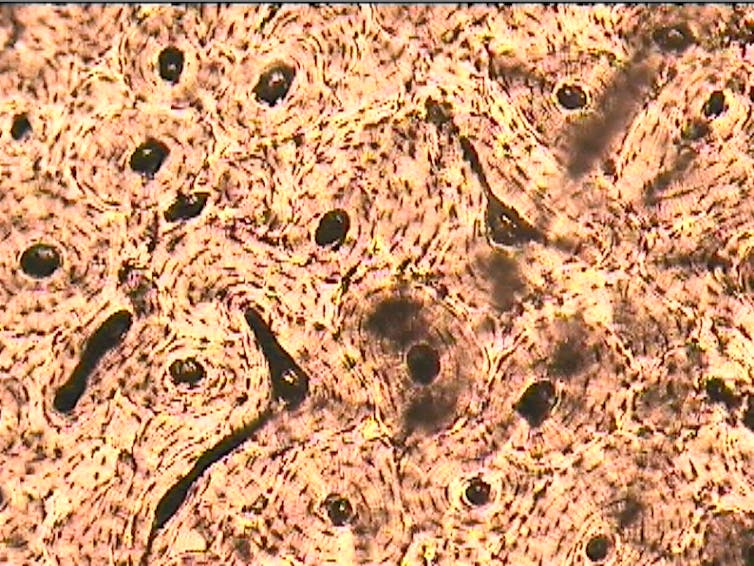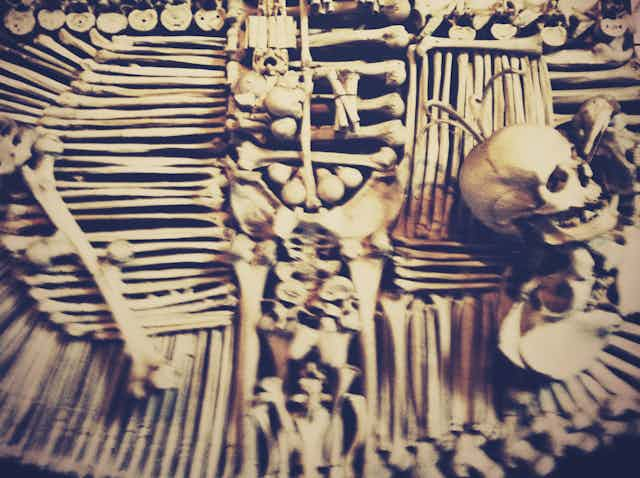Celebrity chef Pete Evans was reported recently as saying “calcium from dairy can remove the calcium from your bones”, and can worsen osteoporosis. The Australian Medical Association has expressed concerns that Evans is disseminating misinformation, and in so doing may endanger lives.
But this brings us to the question of how our bones get calcium, and why they lose it.
Calcium provides mechanical rigidity to bones and teeth, and 99% of the body’s 1kg of calcium is in the skeleton. Calcium is also essential for many other processes, including the function of muscles and nerves.
During periods of fasting, or if dietary calcium is in short supply, calcium is released from bone to maintain the critical level in the bloodstream needed for nerve and muscle function. If a shortage of calcium intake continues over time, bones are likely to become thinner and more porous, and, ultimately, more likely to break or “fracture”.
The calcium in the skeleton of a newborn baby has come from the mother and then from breast milk. But as the baby grows, more calcium will be needed. This can only come from dietary sources. Calcium is absorbed through the gut with the help of Vitamin D.
It then travels in the blood, with some eventually stored with another element, phosphorus, in bone crystals, which increase the strength of bone. Calcium remains there until it is required - for example, when the levels of calcium in the blood fall - when it is released. If the stores of calcium are released repeatedly, the bone becomes weak and thin.
So the level of calcium in the blood each day reflects a balance between what is absorbed from the diet, released from bone and lost through the gut, kidneys and skin.
The loss of calcium through these organs is a normal part of the body’s metabolism (for example, calcium may be exchanged for other elements such as sodium, a component of salt). Absorbing calcium from the diet offsets these losses and allows the body to maintain overall calcium balance between what comes in and what goes out.

Exactly how much calcium is needed varies according to circumstance. For example, more calcium is needed at times of high skeletal activity, such as growth. Other examples of higher demand include pregnancy, breast feeding and menopause.
The recommended daily intake of a nutrient is that needed to meet the needs of 98% of the population. The current recommended daily intake for calcium in Australia and New Zealand for women aged 19 to 50 years and men aged 19 to 70 years is 1000mg/day.
The recommendations are slightly higher in children and adolescents (1000-1300mg/day) and in pregnant or lactating teenagers (1300mg/day).
On average, only about one third of calcium ingested is absorbed through the gut wall, though this can vary depending on other factors. These include how much vitamin D we have in our bodies, which actively increases calcium absorption.
Calcium absorption declines with age. So older people need calcium levels in their diet to maintain calcium balance. Calcium absorption also declines with menopause.
Calcium is absorbed both across and between the gut wall cells. The gut cannot inherently differentiate between calcium obtained from one type of food or another.
Best sources of calcium
Dairy foods are the richest source of calcium in the diet. Although butter and cream do not contribute calcium in significant amounts, other dairy products such as milk, cheese and yoghurt (both full fat and low fat) do. Calcium is in the “watery” part of milk, so using low fat dairy products does not compromise calcium intake.
The 2011/2012 Australian Health survey reported almost half of the calcium intake among Australian adults was obtained from dairy products, particularly in older Australians.
Dairy foods are also excellent sources of protein, which can be particularly important in assisting frail elderly people maintain muscle tone, and thus help reduce their risk of falls.
Although the richest and best absorbed source, dairy foods are not the only source of dietary calcium. Bony fish (such as tinned salmon or sardines), legumes and some nuts such as almonds, and fortified soy milk and breakfast cereals can also provide calcium in lesser amounts.
But absorption of calcium from non-dairy foods may be poorer than absorption from dairy. Calcium is less well absorbed from foods high in a type of acid called phytates (such as seeds, nuts, grains) or substances called oxalates which are found in many plants (such as spinach and beans). This is because they bind to the calcium and make it harder to absorb.
Calcium supplements can also provide dietary calcium. Absorption from calcium supplements depends on their dose (lower doses, usually below 500mg, are absorbed more effectively) and timing (more is absorbed when taken with food). If taken correctly, absorption may be comparable to that from dairy, but higher doses taken without food are unlikely to absorb well.
Why dietary calcium is important
Our bones reach their highest mass during our 20s. Our bones later lose density during normal “ageing”, increasing the risk of fracture. It’s estimated that a fracture occurs every 3.6 minutes in Australian adults aged 50 years and over.
Ensuring adequate dietary calcium intake, maintaining a healthy vitamin D level, not smoking, and participating regularly in weight-bearing and resistance exercise are all important lifestyle measures that can help optimise bone health.
Early research showed an adequate supply of dietary calcium reduces the release of calcium from bone and a higher consumption of dairy products is associated with lower risk of fractures.
Inadequate calcium intake is detrimental to bone health. But once adequate calcium intake is achieved, little additional bone benefits are seen, and supplementing calcium intake above the recommended daily intake doesn’t have much effect on fracture rates.

